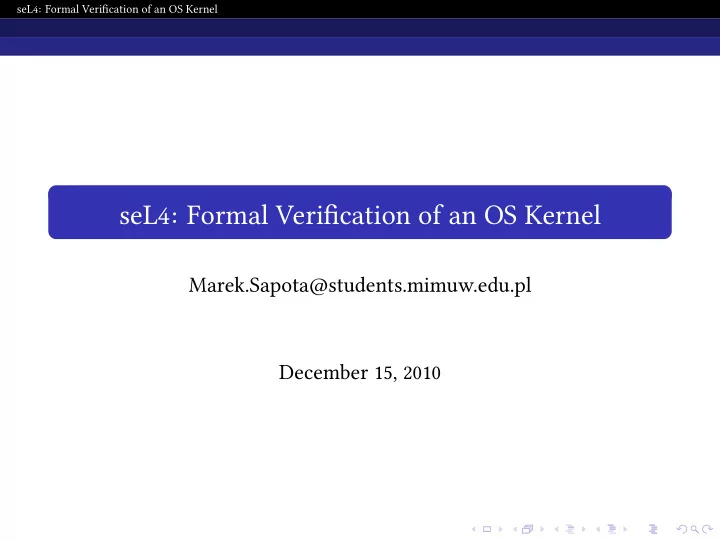

seL4: Formal Verification of an OS Kernel . seL4: Formal Verification of an OS Kernel . Marek.Sapota@students.mimuw.edu.pl December 15, 2010 . . . . . .
seL4: Formal Verification of an OS Kernel About seL4 What is seL4? Secure Embedded L4 Formally verified kernel from the L4 family Runs on ARMv6 and x86 architectures (there is no proof for x86) “Complete, general-purpose operating-system kernel” 8 ‘ 700 lines of C and 600 lines of assembler Microkernel that provides address spaces, threads, IPC and authorisation capabilities . . . . . .
seL4: Formal Verification of an OS Kernel About seL4 What is proved? Behaviour precisely specified at abstract level Implementation is proved to follow abstract level specification and do nothing more Proof of termination and execution safety . . . . . .
seL4: Formal Verification of an OS Kernel About seL4 What is not proved? Abstract specification making any sense Device drivers (not being part of the kernel) Memory allocation Several low level parts implemented in assembler Boot code Compiler correctness Hardware correctness eorem prover correctness . . . . . .
seL4: Formal Verification of an OS Kernel About seL4 What does it give us? It’s impossible to make a buffer overflow aack No NULL pointer dereferencing No accidental uses of pointers to wrong type of data No memory leaks No arithmetic overflows and exceptions in kernel code (eg. no division by zero errors) . . . . . .
seL4: Formal Verification of an OS Kernel Proof overview About proof Proof is done using Isabelle/HOL theorem prover. ere are several proof assumptions: Valid compiler (GCC) Hardware correctness eorem prover is correct Proof was only done for ARMv6 architecture with one CPU. . . . . . .
seL4: Formal Verification of an OS Kernel Proof overview About proof e proof and implementation is split into three phases: Abstract specification — system interface Executable specification — Haskell prototype C implementation . . . . . .
seL4: Formal Verification of an OS Kernel Abstract specification Abstract specification Defines the system interface, describes what the system does, but not how. Every implementation refining this specification will be binary compatible with seL4. Properties: 4 ‘ 900 lines of Isabelle proof Enough detail to specify outer interface of the kernel No implementation details, data structures are high level (sets, lists, trees, etc.) . . . . . .
seL4: Formal Verification of an OS Kernel Executable specification Haskell prototype Executable specification fills in details le by abstract specification and describes how the system works. Prototype properties: 5 ‘ 700 lines of code, 13 ‘ 000 lines of Isabelle proof Runnable with modified QEMU Deterministic (only le non-determinism is hardware) Proved to implement abstract specification Automatically translated to Isabelle script . . . . . .
seL4: Formal Verification of an OS Kernel Executable specification Haskell prototype ere are some restrictions that make automatic translation to Isabelle possible: No substantial use of laziness Restricted use of type classes All functions are proved to terminate . . . . . .
seL4: Formal Verification of an OS Kernel C implementation C implementation C implementation is a manual reimplementation of Haskell code. Haskell runtime is much bigger than the kernel itself and would be hard to be proved correct Garbage collection is not suitable for real-time environments C allows low level optimisations Automatic translation would be easier to prove, but it wouldn’t allow any low level optimisations Properties: 8 ‘ 700 lines of code, 15 ‘ 000 lines of Isabelle proof . . . . . .
seL4: Formal Verification of an OS Kernel C implementation Assembler parts For some direct interaction with hardware assembler is used. For example cache and TLB flushes require direct instructions to hardware. is low level parts of code are not proved correct, but they are traditionally tested. . . . . . .
seL4: Formal Verification of an OS Kernel Verification effort Lines of code 5 ‘ 700 lines of Haskell 8 ‘ 700 lines of C 600 lines of assembler Total of 200 ‘ 000 lines of Isabelle script (including generated proofs) . . . . . .
seL4: Formal Verification of an OS Kernel Verification effort Time Abstract specification - 4 person months Haskell prototype - 2 person years C implementation - 3 person months Total of 2 . 2 person years SLOCCount estimates cost of seL4 implementation at 4 person years, in comparison it took 6 person years to implement Pistachio kernel Cost of proof - 20 person years ( 9 person years for tools, frameworks and automation, 11 person years for seL4 specific proo) All together — design, documentation, implementation and verification — about 25 – 30 person years, to do this again it would be about 10 person years . . . . . .
seL4: Formal Verification of an OS Kernel Conclusions Conclusions Formal verification is achievable for microkernels Performance does not need to be sacrificed for verification Detour via Haskell improved productivity . . . . . .
seL4: Formal Verification of an OS Kernel Future What next? Verification of assembly parts Version of kernel for multi-CPU machines . . . . . .
Recommend
More recommend